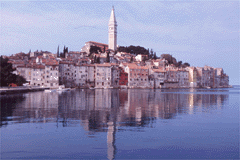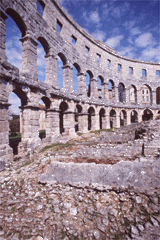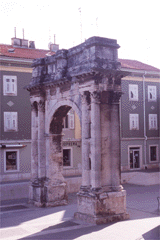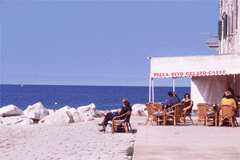May 21, 2000
Adriatic Abundance
By DANIEL LEWIS
Three days in Istria under the benign gaze of St. Euphemia. Watch out for grape-laden donkey carts.
FRESH breeze off the Adriatic sailed into my room, filling the curtains like spinnakers, and I was instantly awake. If I rose before dawn, I could explore the cobbled streets of Rovinj at first light and watch by the harbor while sunrise caught the old town in high relief: the ancient stone houses, all mass and texture, and the steep Venetian ones, all line and color, under the equal protection of a copper St. Euphemia, poised on her bell tower 200 feet in the sky.
That there was a serious gap in this mental picture didn't hit me until I actually went outside. I had imagined, out of tourist's innocence or vanity, having this town on Croatia's Istrian coast to myself. Instead, all of Rovinj (pronounced roh-VEEN-yah) was awake in the half-light, ready to draw me into its own, more purposeful version of the morning.
The Church of St. Euphemia rises above Rovinj, on the Adriatic Sea. 
Mark Edward Smith for The New York TimesThe town mascots, a family of wry little dogs, were going someplace with their quick feet on. People dressed for work had begun talking the day into focus outside three or four waterfront cafes.
At the bread shop, an old woman in black read a bulletin board that says "death notices" in Hrvatski and Italian; among these notici mortuari was the beautiful name of Sonia Caterina Curvo, who was only 51.
Up the street, two kids in baggy jeans were transfixed by a movie poster: "Star Wars, Epizoda I," here at last.
St. Euphemia herself -- patroness, beacon, weather vane -- had apparently been on duty all night, and at this hour still glowed in the spectral light of flood lamps. In a darker quarter below, the fish market was open, and the produce market next door was already doing a good business -- here, in one block, were all the required ingredients for good Istrian cooking. Besides fruits and vegetables, the stalls had local olives, fragrant green olive oils, walnuts, dried fruits, wines, grappa, honey, cheeses.
But the big food news this third week of October was native truffles, black and white, in outrageous abundance. We had lucked into the heart of the truffle-hunting season. For the next couple of days, my wife and I could hardly order a meal that didn't involve some dish full of fungi, sliced, diced and, relatively speaking, underpriced.
Istria, the bit of Croatia that dangles like a heart pendant in the Adriatic Sea, plays to a wide range of tastes. In the fall and spring, life runs more nearly true to the old maritime-agricultural rhythms. These are good times to enjoy the countryside and its food and excellent wines. If you're partial to stone and mortar, there are some impressive Byzantine and Roman monuments, too, including an amphitheater in Pula that's still very much in the business of spectacles.
Istria, a five-hour trip by train and rental car from Venice by way of Trieste, was an easy fit with our travels in northern Italy. It is about a six-hour drive from Munich. Because of this general accessibility, Istria is the most-visited part of Croatia.
It's also perhaps the least typical in its outlook. In the national elections of 1993, when Croatia's xenophobic Franjo Tudjman was at the height of presidential power, his political party essentially had to concede Istria County to the local opposition; the Istrian Democratic Assembly got 73 percent of the vote.
Geographically, Istria was too far away to hear a shot fired in the brutal disintegration of Yugoslavia. But its economy was affected and has yet to recover. Big British travel packagers, who once supplied 20 percent of the tourists, took their business elsewhere. Today, only 2 percent of foreign visitors are British (even fewer are American).
Coming in from Italy, through a little piece of Slovenia, we got a robust greeting as we drove into the Istrian hills: billboards for Super Bingo, and for the seaside resorts of Umag and Porec, where tens of thousands of hotel rooms and camping sites are strung along miles of shoreline. We weren't going there, having already decided not to spend our three-night visit hopping from point to point. Besides enjoying the sea, air and historic architecture in Rovinj, which would be our base, all we had in mind was a day in Pula, Istria's principal city and repository of its epic history, and part of a day in the uplands around the medieval towns Groznjan and Motovun.
The 2,000-year-old Roman amphitheater in Pula. 
Mark Edward Smith for The New York TimesThese hills of north and central Istria -- actually, foothills of the Julian Alps -- recall what "rustic" looked like before the term became self-conscious. You will get the inevitable photo op of the Mercedes blowing past the grape-laden donkey cart.
Among the hill towns, Groznjan, especially, has enhanced its blunt charm and long pastoral views with a cultural life that includes music camps, art galleries and an international film academy. But there are many places where you can still look across a valley that's been worked in the same cycles for a thousand years, or buy a bottle of wine from the family that picked the grapes. Distance from the noise and cultural flattening of mega-Europe is not the least of Istria's off-season charms.
A good vantage point is the high town of Motovun, overlooking the Mirna River valley: a steep walk up stone-paved streets, rewarded by a 360-degree view from the ramparts. The town square includes the Renaissance St. Stephen Church, with a tower you can climb for 5 kuna (roughly 60 cents); a cafe; the tidy Hotel Kastel, and a delightful old movie house, Motovun's own cinema paradiso, refitted for the inauguration of a mini film festival last summer.
Pula, Istria's largest city, is near the southern tip of the peninsula -- only a 45-minute drive from our Rovinj hotel, it turned out. Pula is a haven for Adriatic yachtsmen, but more notably a ship-building center, and over all a business-minded place. It's well worth a day's visit seeing what the Romans built there after their subjugation of the Illyrians -- the first in a series of occupations by Byzantines, Slavs, Celts, Venetians, Austro-Hungarians, the French, Italians, Germans and the Allies, among others, before Istria was awarded to Yugoslavia in 1947.
We were tooling around the city in a five-speed Fiat, following the harbor, when the thing we were looking for seemed to find us: Pula's amphitheater, rising in a leafy, relatively quiet district of the old city.
Big, to be sure: it's supposed to be the third largest Roman amphitheater.
More impressive are its lofty design and sound condition.
The amphitheater was built of white limestone in the first century. Except that its tiers of stone seats were later taken for use in other construction projects (replaced with wooden benches), it may look nearly as good today as it did 2,000 years ago, when guys bashed heads to the cheers of 20,000 spectators.
Modern Istrians have kept the amphitheater working with film festivals, operas and rock concerts. But for a part of this mild October afternoon, we were alone there, scaring ourselves with thoughts of what it must have been like to stand in the way of a people that could build such a thing wherever they pleased.
From the amphitheater, it's a block or so to Ulica Sergijevaca, a busy, pedestrian-only street that follows the ring layout of the original Roman city. Several blocks along, on the northern rim, is the Triumphal Arch of Sergius, whose unexpectedly intimate scale and integration into the daily flow of life were a pleasant surprise. Michelangelo, among many others, came to study the arch's famous classical proportions.
A footnote for Bloomsday-trivia types: the handsome old building a few feet from the arch was once the Berlitz school where James Joyce taught English after running away from Ireland with Nora Barnacle in 1904. While a plaque on the building briefly notes its association with the "great Irish author," the story is worth a bit more than that.
During his stay in the town, then called Pola, Joyce wrote the so-called Pola notebook, laying out the esthetic principles that his character Stephen Dedalus later elaborates in "A Portrait of the Artist as a Young Man." The down side was that Pola, the main base of the Austro-Hungarian navy, was oppressive and suspicious of foreigners. Joyce called it "a naval Siberia," and before long he was sent to Trieste, a more cosmopolitan outpost of the empire, where he stayed until World War I.
No one traveling to Pula should pass up the chance to eat at Valsabbion, located somewhat oddly in an upscale suburban yacht harbor a few miles south of the central city. We considered our two meals at Valsabbion, prepared with a spirit of invention and a respect for fresh local ingredients, to be among the finest we've had anywhere.
The first-century Triumphal Arch of Sergius in Pula. 
Mark Edward Smith for The New York TimesFrom the fish menu alone, we sampled baked fresh sardines with cornmeal crust, tiny oysters served with sea bass carpaccio, a whole giant prawn, sea bream baked in salt, a delicate fish soup with vegetables, and baked squid. Then there were two risottos, served in scooped-out ewes-milk cheeses from the island of Pag; turkey breast with a sauce of wild berries and sour cherries; and, of course, truffles, with roasted potatoes and beef carpaccio. The more expensive of the meals came to less than $70 for both of us, including first-rate Istrian wines.
The food was fine at less exalted restaurants just a few hundred feet from our harborside hotel, the Sol Inn Adriatic, which only strengthened our impression of Rovinj as an ideal place to stay.
Besides being very picturesque, at least in the old-town section that juts out into the sea, Rovinj has a comfortable way of balancing its own day-to-day life with the needs of visitors. Stores are open late. Everyone speaks Italian, and to judge by our experience, German and English as well. Rovinj also seems particularly child-friendly -- it has an aquarium and boat trips to nearby islands.
As for the Sol Inn, the sunny charm of the stucco exterior didn't quite prepare us for the utilitarian renovation of the interior, and the lack of an elevator might be a problem for guests on the third and fourth floors. But we would happily stay there again.
Outside the old town, Rovinj, like some other parts of Istria, is growing. Big two-story houses are going up. There are real estate ads on the Internet with prices in dollars and marks, a trend likely to accelerate under the political loosening that followed the death of President Tudjman last December. "Luxury" hotels from the Tito era of industrial tourism are being upgraded.
In short, there's a feeling in the air that Istria is about to be invaded for the umpteenth time in 3,000 years -- this time, with any luck, by the kind of people who just want to unwind with a few drinks, a few laughs or a few truffles.
A jewel of a peninsula on the Adriatic
Lots of information on lodging, restaurants, festivals and landmarks is available at www.istra.com (Istra is the native spelling of Istria). Searching can be confined to a particular town by adding a slash and the name of the town, as in www.istra.com /rovinj. These pages link to forms for making hotel reservations, but be sure to get a confirmation.
A cafe in Rovinj, right on the Adriatic. 
Mark Edward Smith for The New York TimesThere is a Croatian National Tourist Office at 350 Fifth Avenue, New York, N.Y 10118; (800) 829-4416, fax (212) 279-8683.
Getting Around
Most sizable towns in Istria are reachable by public bus, but the practical choice for any short-term visitor is a car. If renting a car in another country, make sure the rental agency gives you a verifying document including the agency's phone number since the authorities sometimes stop drivers, looking for stolen cars.
Where to Stay and Eat
Rovinj has a sterile-looking luxury hotel, the Melia Eden, on Luja Adamovica, (385-52) 800-400, fax (385-52) 811-349. Rates, including breakfast and dinner, range from $52 to $63 a person in July and August, at the exchange rate of 8.5 kuna to the dollar. In spring and fall, rates fall to about $40 a person, and the hotel closes in February and much of November.
We preferred the more picturesque location of the less expensive Sol Inn Adriatic, Piazza Maresciallo Tito 5, Rovinj, (385-52) 815-088, fax (385-52) 813-573, right on the harbor in the old town. We got a big room with a sea view and a private bath for around $40 a night, sumptuous buffet breakfast included; in summer, a double, with breakfast, is about $70. The hotel is closed from early January to Easter.
There are several hearty restaurants (fish, pasta, lamb) a short walk from the Adriatic. We sampled Amfora and the funkier Veli Joze, which makes fine stews, and paid less than $30 for two, including wine or beer.
There's probably no compelling reason to stay overnight in Pula, but you could do worse than the Hotel Riviera, a properly impressive Old World place a few blocks from the Roman amphitheater at Splitska Ulika 1, (385-52) 211-166, fax (385-52) 219-117. Doubles cost $35 to $56, including breakfast.
On a more intimate scale, in the neighboring suburb of Pjescana Uvala, Valsabbion (which houses a superb restaurant of the same name) is a sunny inn with several contemporary Mediterranean-style rooms, spa services, a fitness center and a small rooftop pool at Pjescana Uvala IX/26, telephone and fax (385-52) 218-033; www.valsabbion.com. Depending on the season, doubles range from $36 to $106.
Things to Do
In Pula, the Roman amphitheater, on Falvjeska Ulica,(385-52) 219-028, is open 8 a.m. to 9 p.m. in summer, to 4:30 in the off-season; admission, about $2, $1 for children and seniors.
The nearby pedestrian street, Ulica Sergijevaca, is a trail of history, including the Triumphal Arch of Sergius and the Temple of Augustus.
Also close by, on Ulica Carrarina, is the Archeological Museum, (385-52) 218-603, fax (385-52) 212-415, which has artifacts from all over Istria. It is open 9 a.m. to 3 p.m. Monday to Friday (till 8 p.m. in summer) and 10 a.m. to 5 p.m. on weekends. Admission is $1.40 and 70 cents for children and seniors.
In Rovinj, the baroque Cathedral of St. Euphemia, has a commanding view of the town and, inside, the sarcophagus of St. Euphemia, which according to legend disappeared from Constantinople around 800 and miraculously washed up on the Rovinj coast.
-- DANIEL LEWIS